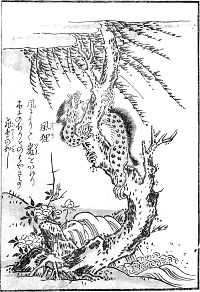Fūri


Fūri (Japanese: 風狸) is a yokai of China and Japan. They are also called Fūseijou (風生獣), Fūbo (風母), and Heikō (平猴).[1] The name can be seen in the Bencao Gangmu of China, and in the Japanese works Konjaku Hyakki Shūi by Toriyama Sekien, the Mimibukuro by Negishi Shizumori, and in the Wakan Sansai Zue as well as other literature from the Edo period.
Outline
In animal 2 section of Bencao Gangmu,[2] it stated that it has a size about that of a tanuki or an otter. Its condition is that of a monkey, has red eyes, and has a short tail. It has blackish, leopard-like pattern. From its nose to its tail, it has blue hair.[1] It was also written that it feeds on spiders, and also eats the scent of fragrant wood,[1] and that it doesn't move around during noon, and at night, it glides around like a bird between trees and around rocks,[1] and that when it is captured in a human's net, it behaves as if it were embarrassed, and makes a gesture as if it was asking for pity.[1] It was also written, that furi die not before long when they get struck by something, but revive just by receiving wind in their mouths. There are also theories that the blade would not go through even if cut by a blade, and that they won't burn in flames. However, if their bones or head is broken, they cannot revive, and that by blocking their nose with a Japanese sweet flag, it is possible to kill them.[1]
Its flight distance is said to be enough to cross over one or two mountains.[3] In the Bencao Gangmu, they are indicated to be the Colugo from Southeast Asia.[3]
In the Sakan Sansai Zue, it was stated that there are no fūri in Japan, but in Mimi-bukuro, it was stated that there were also tales in Japan about fūri. According to that, it is a type of tanuki, and by pulling a type of grass, and holding it out towards a bird that has stopped on a branch or treetop, the bird would for some reason fall down, so it serves as a bait. It is unclear what type of grass has that effect, but someone had the grass stolen one from a fūri, tried to catch the bird by climbing a tree, and when he held it out the bird, the bird and that person both fell from the tree.[4]
See also
References
- ↑ 1.0 1.1 1.2 1.3 1.4 1.5 寺島良安 (1987). 島田勇雄・竹島純夫・樋口元巳訳注, ed. 和漢三才図会. 東洋文庫 6. 平凡社. pp. 93頁. ISBN 978-4-582-80466-9.
- ↑ 李時珍 (in Chinese).
 本草綱目/獸之二#.E9.A2.A8.E7.8B.B8. Wikisource.
本草綱目/獸之二#.E9.A2.A8.E7.8B.B8. Wikisource. - ↑ 3.0 3.1 多田克己 (1990). 幻想世界の住人たち. Truth in fantasy IV. 新紀元社. pp. 87頁. ISBN 978-4-915146-44-2.
- ↑ 根岸鎮衛著 (1991). "風狸の事". In 長谷川強校注. 耳嚢. 岩波文庫 下. 岩波書店. pp. 220頁. ISBN 978-4-00-302613-7.